India’s road transport sector accounts for about 87% of passenger traffic and 60% of freight traffic movement in the country. For many Indians, road transport is one of the most cost-effective and preferred mode of transport. This is true for both freight and passenger transport. A wide road network, the availability of a variety of transport modes that suit all kinds of individuals, as well as opportunities for low-cost travel are some of the reasons why road transport is popular and preferred.
In today’s world, road transport has become an integral part of the human experience. Virtually everyone is a road user in one way or the other. In recent years, India has developed many high-speed transport corridors that have minimised distances between people, businesses, towns, and cities. On the other hand, they have also increased the risk to life. Every year, road accidents result in the loss of lakhs of lives, and serious injuries to crores of people all over India.
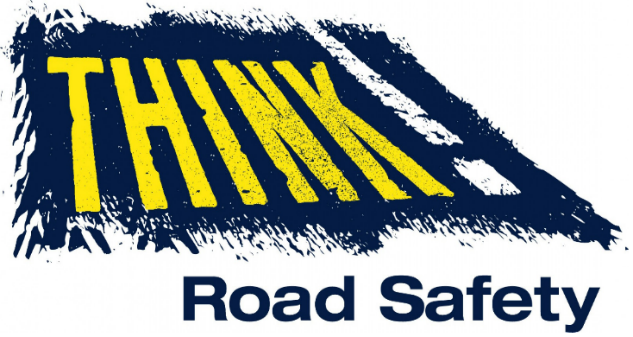
According to official data by the Ministry of Road Transport and Highways, India ranks first in the number of deaths caused by road accidents, accounting for almost 11% of road accident-related deaths worldwide. In 2019, over 1,50,000 people died every year from road accidents in the country. The WHO’s estimate of 2,12,000+ is even higher than the Ministry’s. These numbers prove that road safety is a major public health concern in India, and that we as a society must take cognizance of the issue. More importantly, we must join hands to make road safety a social movement that benefits each one of our 1 crore+ population.
(As per Official Data Ministry of Road Transport and Highways – The data has been used only for reference)
Road accidents, Number of persons killed and Injured in the last five years 2015-2019:
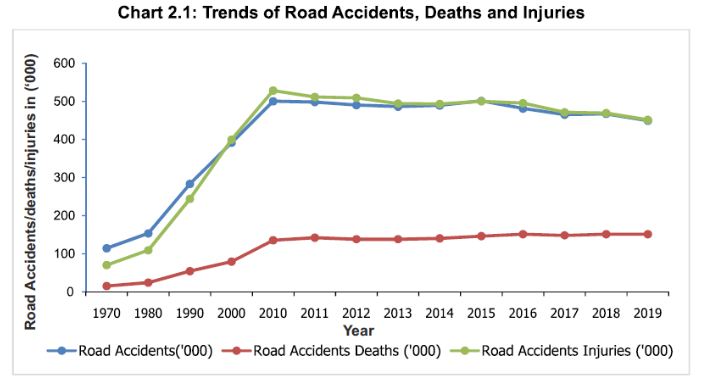
Persons Killed in Road Accidents in 2018 – State-wise:
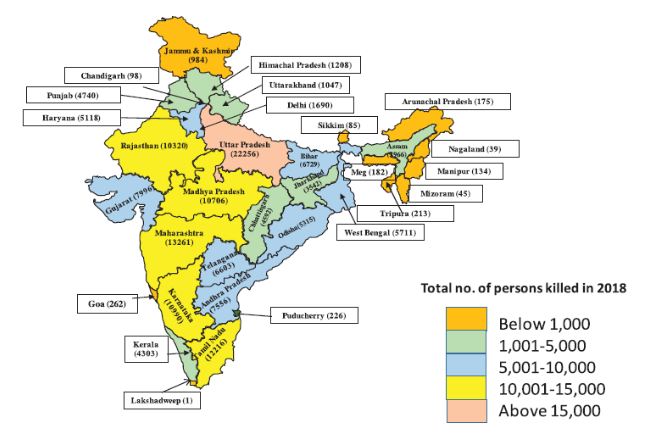
Persons Killed in Road Accidents in 2019 – State-wise:
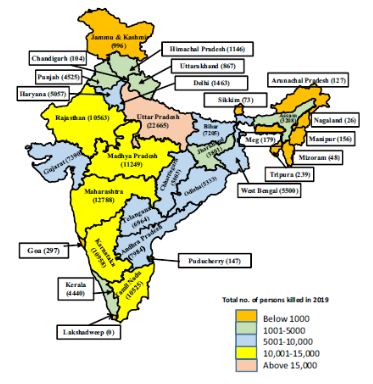
Different Vehicle Types in Road Accidents During 2018:
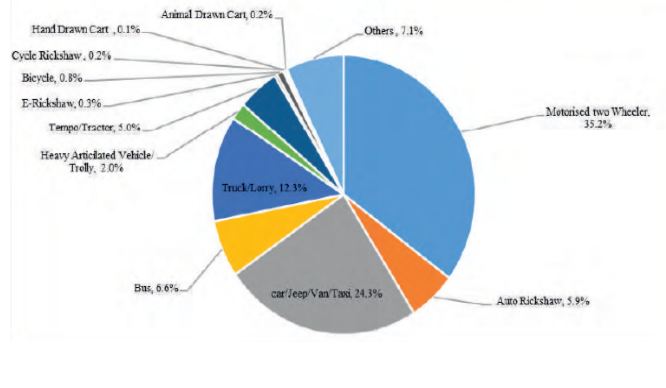
Different Vehicle Types in Road Accidents During 2019:
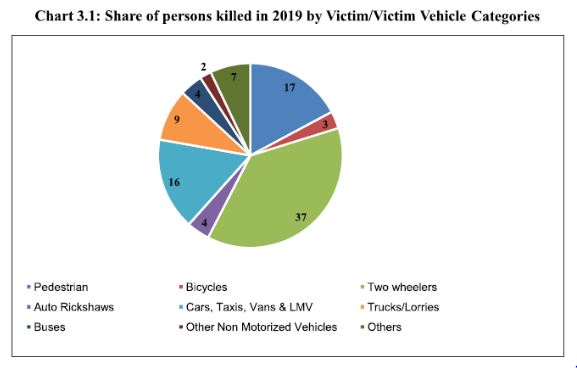
Age Profile of the Victims of Road Accidents-related Deaths in 2018:
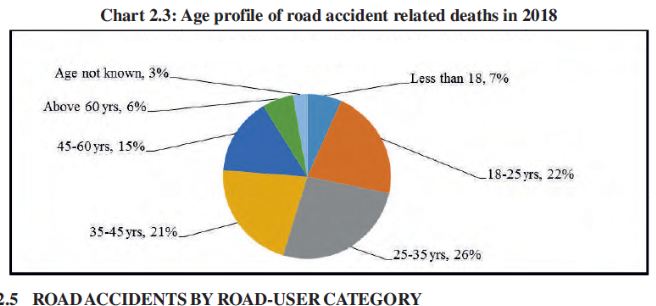
Age Profile of the Victims of Road Accident-related Deaths in 2019:
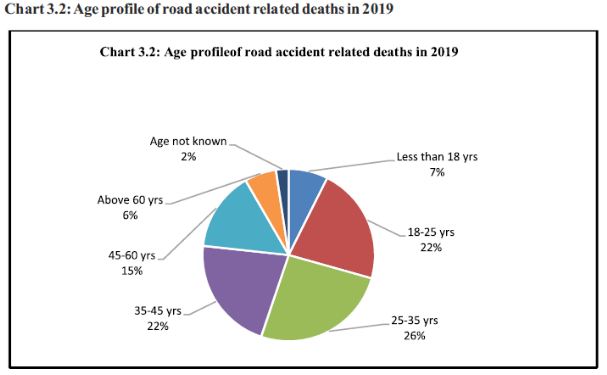
As per the Minister of State for Road Transport & Highways’ annual report on road accidents (based on data reported by state police departments throughout India), road safety continues to be a cause for concern, even though the number of road accidents fell between 2018 and 2019:

Even with slightly smaller fatality numbers, road accidents were a grave matter of concern in 2019. In 4,49,002 reported traffic accidents, 4,51,361 people were injured. Unfortunately, 1,51,113 people died. In comparison to 2018, the number of road accidents decreased by 3.86%, fatalities decreased by 0.20% and injuries declined by 3.85%.
However, accident severity expressed in terms of number of persons killed per 100 accidents rose from 32.4 in 2018 to 33.7 in 2019. This increase shows that the country is losing a lot of valuable human potentials through road accidents.
The Ministry has stepped up its efforts to address the lack of road safety in India through a series of measures that include improving road infrastructure, road safety audits, identification and rectification of black spots on roads, strengthening the automobile safety standards, organising road safety awareness programme and strengthening enforcement etc.
Unfortunately, there are many causes for road accidents in India. These include:
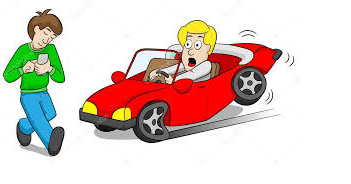
- Human Error
– Incompetent drivers
– Vehicle over-speeding
– Dangerous overtaking
– Traffic rules violations
– Driving under the influence of alcohol or drugs
– Usage of mobile phones while driving
– Distracted/unfocused driver due to radio, billboards etc.
- Vehicular Condition
– Failure of brakes
– Failure of steering
– Fuel leakage
– Damaged wheel
– No safety features, such as airbags, seatbelts, anti-lock braking system (ABS), etc.
- Road Environment
– Damaged or potholed roads
– Slippery roads
– Sudden obstruction (objects on Road such as a tree, potholes, etc.)
– Unmarked level crossing
– Inadequate lighting
– Rain, fog, smoke, or other environmental conditions
Improvement of road safety is a major public health concern, and of prime importance to minimise road accidents, and accident-related injuries and deaths. With the number of vehicles on our roads increasing with every passing hour, it is of vital importance for every Indian to have traffic awareness and understand and respect all the road safety rules.
These rules include all of the below:

- Stop or slow down:
Allow pedestrian to cross first at unmanned zebra crossings. They have the right of way.
- Speed limit:
Obey speed limits for your own safety and the safety of others. In industrial areas, and near marketplaces, schools and hospitals, the maximum speed should be no more than 20kmph.
- Traffic rules and signs:
Always obey all traffic rules and signs to prevent road accidents.
- Competent driver:
The driver must be competent, medically fit, and have valid license to operate the vehicle. In India, licenses differ by vehicle type, which means that a driver with a license to drive a car cannot drive a truck or lorry.
- Drive carefully:
Never drive dangerously to ensure your own safety and the safety of other road users. This means no overtaking from the left, always maintaining a safe distance between vehicles, and never using a mobile phone while driving.
- Be courteous:
Be considerate of other road users since you share the road with all of them. Never rage on the road; it is dangerous for you and for everyone else.
- Always keep to the left:
Keep to your left in a two-way lane; When turning right, arrive at the centre of the road and then move to the left of the lane you enter.
- Crossing rules:
At road intersections or while turning corners, slow down. Wait until there’s no moving traffic. Never obstruct an oncoming vehicle.
- Overtaking:
Allow other vehicles to overtake you from the right and do not increase your speed to prevent being overtaken. While overtaking, always stay on the right side of other vehicles.
- Maintain distance:
Adequate distance must be maintained between two vehicles to prevent a collision. This can happen if the vehicle on the front suddenly slows down or stops without warning.
- Protective gears:
Seat belts must be worn at all times by drivers and passengers in four-wheel vehicles to prevent or reduce the severity of accidents. For two-wheelers, riders – and preferably their pillion as well – should use ISI certified helmets.
- Mobile phones:
Do not use mobile phones while driving as it can distract you and cause a fatal accident. Always keep your eye pinned on the road ahead.
- Drinking:
Like mobile phone, drinking while driving should be strictly avoided. Alcoholic beverages reduce our ability to focus and drive carefully.
- Vehicle condition:
The vehicle should be in a good condition to prevent frequent breakdowns and difficulty in controlling which may lead to accidents.
- Safety features:
The vehicle’s safety features should be in peak working condition.
- Emergency facilities:
Emergency facilities like fire extinguisher, first aid box etc. should be available in the vehicle.
- Legal documents:
All important legal documents for the vehicle, such as registration certificate, insurance certificate, PUC certificate should be available.
Although the government has been proactive in addressing various road safety strategies, we conclude that as a country, we still need to focus on a few points to improve safety and reduce accidents. These include rules for pedestrians and other non-motorists, safe designs of motorcycles and other motor vehicles, road measures and designs, legal enforcements, and continuous data analysis.
The Tamil Nadu ExampleTamil Nadu’s great experience in increasing road safety has a number of vital lessons that can be studied and applied across India. Until 2018, Tamil Nadu was one of India’s worst states for traffic accidents and fatalities, with over 12,000 people killed in that year.
Tamil Nadu’s Road deaths have decreased by over 25% in the last five years, to 10,000 by 2019. It’s worth noting that enhancing road safety in the state did not come at the expense of economic growth, but rather aided it. The state concentrated on coordinated management of multi-sectoral actions, bringing all stakeholders together and forming a Road Safety group with decision-making authority.
Effective traffic management of emergency vehicles like ambulances at signalised junctions helped reduce their travel time, which in turn improved their response time. This aided in the improvement of the trauma care system in TN.
With the use of a GIS-based Road Accident Database Management System, the state created a first-of-its-kind crash database system to address road safety concerns. This technology plots road incidents, identifies crash hotspots, and recommends remedial activities. This has also been used as a model for replication at the national level in other states. TN also used pedestrian footpaths, fences and crossing facilities, traffic calming, signs, and channelisation to adapt its infrastructure to increasing urbanisation. Early achievements in Tamil Nadu suggest that well-implemented data-driven, evidence-based road safety interventions can potentially produce the desired results all over India.
Other Possible Strategies to Boost Road SafetyIn addition to learning from Tamil Nadu’s road safety initiative, there are other strategies that can be implemented to improve road safety in India. One is speed management, which would aid in reducing the number of and severity of road accidents. Setting and enforcing suitable speed limits is thus a key method for reducing road deaths and serious injuries.
To make the environment safer for vulnerable road users, more effort must be expended on road infrastructure design that is suitable for mixed (vehicular plus foot) traffic. This would necessitate adopting proven design principles and regulations for (a) roundabouts, (b) service lanes on all intercity routes, and (c) traffic calming on city streets and highways that pass-through cities.
The world is facing a worldwide road safety problem that has yet to be acknowledged. It will only worsen unless suitable implementable and user-friendly actions are initiated and put in place. Stakeholder management and engagement is one of the most critical factors for improving road safety in India.
Institutional ResponsibilitiesWhile there are several interventions that can save lives, political will and duties are crucial, and little can be accomplished without them. Now is the moment to act. Every road user deserves a better and safer driving experience.
Although there is no certainty that these measures would prevent fatal road accidents, we can definitely reduce the risk by being cautious on the road and obeying all safety standards. Road accidents are a primary cause of injury and deaths in India, and they occur at a higher rate when traffic laws are violated.
The government of India promotes road safety management, yet there are obstacles that risk road safety. Apart from this, road safety campaigns have become a powerful factor in making people aware of the importance of driving with caution. By engaging with the community through such campaigns and spreading awareness, we can change unsafe behaviours on our roads.
People ResponsibilitiesRoad safety is vital for all drivers and pedestrians, and research suggests that all of us should make a larger effort to make traffic safer for everyone. When we get behind the wheel to drive, we should be more cautious and less impulsive. There has to be priority for pedestrian safety on all roads, including on national highways.
To summarise, strong cooperation and teamwork are required to address the problem. India also needs a comprehensive and integrated strategy that spans sectors and disciplines which would also include the concept of long-term sustainability.
Source: https://morth.nic.in/road-safety